| |
It's called the Enchantments for a reason. Part of the Alpine Lakes Wilderness in central Washington's Cascades, the Enchantments is an area of surprising delights for day hikers and backpackers, a truly fascinatingly, magical region.
| |
 |
|
 |
|
| |
The Alpine Lakes Wilderness |
|
An Enchantments resident |
|
It's an area that friends and I have wanted to visit for years. But, because of a strict quota system, obtaining a permit is like winning the lottery. So when Jim Johnson, a friend of a friend, needed some companions after winning a rare permit providing access to the tightly controlled core zone, we jumped. Our reward was five amazing days of backpacking. From rigorously challenging terrain to crystalline blue lakes to curious mountain goats, the Enchantments exceeded our expectations.
| |
 |
|
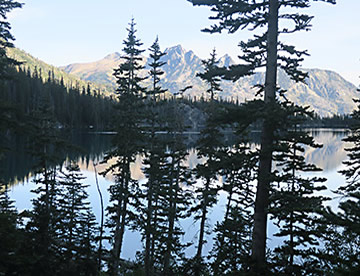
|
|
| |
On the trail |
|
Colchuck Lake |
|
On paper the hiking distances aren't daunting. The loop trip from the Colchuck Trailhead to Colchuck Lake and across the Upper, Middle and Lower Enchantment lakes to the Snow Lake Trailhead is 18 to 19 miles. But in the Enchantments a mile isn't necessarily an ordinary mile. These are challenging miles encumbered with obstacles - boulders, tangles of tree roots - along rugged, exceeding steep up- and downhill terrain.

Steve, Jim and Allan
Jim, who had made two previous Enchantments visits, led our foursome that included Steve Underwood, Allan Wiegman and me. Steve, my hiking-climbing companion for than 20 years, was the common thread, having worked with both Jim and Allan. Jim led the way on an often stumbly four-mile, 2,200 foot elevation-gain trek to Colchuck Lake.
| |

|
|
 |
|
| |
Aasgard Pass from below |
|
Halfway up, looking back |
|
The true test came a day later. Starting early to avoid sunlight and unusually high temperatures, we followed a cairn-marked trail around Colchuck's southern shore, one that meandered around and over boulders, through pockets of subalpine firs and across babbling creeks. From below we looked up Aasgard Pass, an uphill slog that gains nearly 2,400 feet in about a mile. There is no "trail," just an elevator-like steep route up loose talus fit for mountain goats.

Watching our progress
Mountain goats are part of the Enchantments experience. As we clawed our way up the pass, an adult and its kid never broke stride as they casually passed us. Steve, Allan and I madly clicked photos while Jim, knowing we'd see dozens more, chuckled. And, just as Jim knew, after googolplexing more photos and encounters over the next few days, we eventually barely acknowledged their presence.
The goats were only a brief diversion from climbing - make that scrambling - over boulders, loose rocks and scree as we ascended the pass. There were ample excuses to pause and savor views back to Colchuck Lake and neighboring peaks, including the massive pyramid known as Dragonfly.
The Upper Enchantments

Crossing a snowfield
At the summit we entered another world. Much like the Sierra Nevadas, the Upper Enchantments is a surreal landscape of glacier-carved granite and lakes surrounded by sky-piercing, ragged, knife-edged mountains. Even though it was an unseasonably warm August, the trail sometimes cut through snowfields. We passed alongside Tranquil and Isolation lakes, sometimes gawking and being amazed, while Jim surged ahead. He returned after leaving his pack at an off-the-trail site we dubbed Inspiration Camp, a place he'd camped on previous outings.
Grazing goats
| |
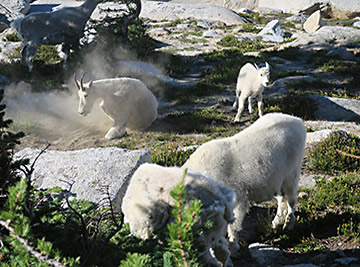
|
|
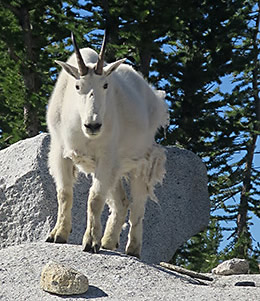 |
|
| |
Digging dirt |
|
Shaggy Mane |
|
We soon had company - a herd of mountain goats. During our two-night stay, some revealed distinct personalities, including Shaggy Mane, so named because of its unruly patches of not-yet shed wooly white fur. Some took turns tumbling in a dirt patch or drank from a stream. We followed mountain goat etiquette by piddling on rocks, not the ground. Goats crave salt, which is found in urine but is a rare nutrient in mountain environments. When not using the primitive privies, peeing on rocks prevents goats from tearing up the ground.
There was more to appreciate. A dipper lived up to its name - splashing, bobbing and diving in the stream. A pika scooted in and out of the rocks near our cooking area. A Clark's nutcracker flew inches overhead looking for food to snatch. Chipmunks and chickarees made appearances. Larches, tall, thick-barked deciduous trees with weeping branches, provided occasional shade.
| |
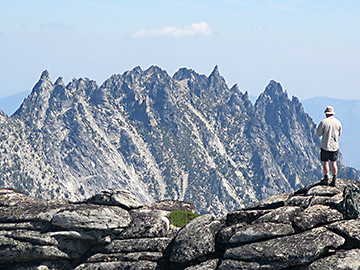
|
|
 |
|
| |
From atop Annapurna |
|
On the summit |
|
Our rest day featured a hike up Little Annapurna, a rumble-tumble of rocks and boulders. It wasn't until we had views from its 8,364-foot top - a series of three side-by-side summits that looked like tall stacks of pancakes - that we found the trail we hadn't followed on the way up. Instead, Jim had purposely led us to vantages atop steep drop-offs for dramatic views of ragged-edged peaks and a far- below lake. The summit views were even better, with Glacier Peak, Mount Baker and, far more staggeringly imposing, bulky snow-covered Mount Rainier.
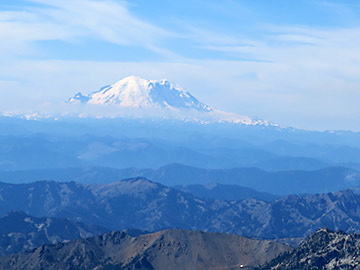
Mount Rainier
On day four we left the Upper Enchantments, dropping first to the Middle Enchantments: Inspiration Lake, with granite walls rising steeply on three sides, then down to and around aptly-named Perfection and Sprite, aqua-blue lakes strung like pearls. Craggy Prusik Peak and The Temple seemed even higher and more remote as the trail - sometimes again crossing snowfields - dipped to the Lower Enchantments, to vividly blue Leprechaun and Viviane lakes. All the while, we passed wildflowers and berry bushes - twinberries, elderberries and huckleberries - watched osprey circle above the lakes, and were surveyed by new bands of goats.
| |

|
|
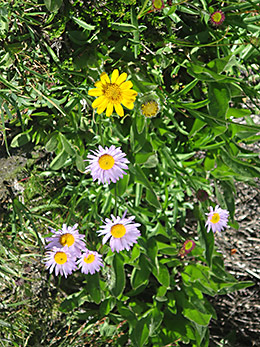 |
|
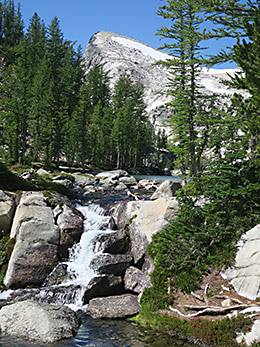 |
|
| |
Snowfields to Perfection |
|
Trailside wildflowers |
|
Looking back at Annapurna |
|
A bit of history: The Enchantments were named by A.H. Sylvester, a Forest Service worker who explored the region in the early 1900s. As he wrote of his discoveries, "I found 5 or 6 most beautiful small lakes grouped in a wonderful glacial valley all ringed with alpine larch. From the highest lake over an entrancing fall tumbled the water it received from a small glacier. It was an entrancing scene. I named the group 'Enchantment Lakes.' "
| |
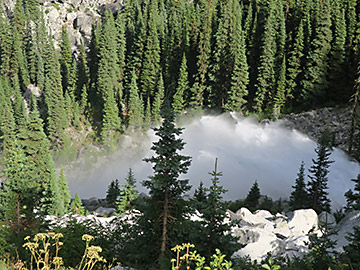 |
|
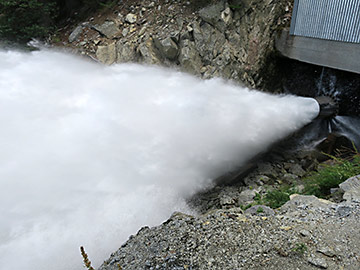 |
|
| |
Water plumes from a distance... |
|
...and up close |
|
From enchanting Leprechaun Lake, an elevation of 6,875, the trail began its steady descent to the Snow Lakes trailhead at 1,280-feet. Only occasionally could we relax, instead having to focus on navigating the mumbo-jumbo of rocks, boulders and debris. We weaved downhill to and around Upper Snow Lake, crossed a rock dam past Lower Snow Lake and then, on our way to Nada Lake, took a side trail to a bewildering sight. During the summer, huge plumes of cold water from Upper Snow Lake blast out a 9-foot-wide, 2,250-foot long tunnel.The cool water meanders through Lake Nada and along Snow Creek to a downstream salmon fish hatchery, built from 1938 to 1942, before Alpine Lakes was a designated wilderness.

Lake Nada
Though it's not part of the Enchantments core zone, Lake Nada provided a delightful site for our final night. Early the next morning we began hiking 6-plus miles along a switchback trail that dipped and wove through pine and cedar forests, eventually ending at the Snow Lakes Trailhead. Cruising along the suddenly-groomed trail, we passed climbers, day hikers and backpackers laboring uphill.
The Enchantments are aptly named. It is an enchanting area, a sublime place where magic takes many forms. But experiencing the Enchantment is hard earned - there's no easy way in or out. That's part of the attraction.

Enjoying its home
If You Go
Permits are required for day and overnight hikes in the Enchantments from May 15 to October 31. Because of the high demand, permits are available in a pre-season online lottery at recreation.gov, usually from mid-February to early March. Limited numbers are also offered on an unreserved, daily walk-in basis at the Wenatchee River Ranger Station, 509-548-2550, in Leavenworth, Wash. For information visit the Okanogan-Wenatchee National Forest website at www.fs.usda.gov/detail/okaen/passes-permits/recreation or call the Recreation Gov reservation line at 877-444-6777. The two primary trailheads, Snow Lakes and Stuart Lake, are both located near Leavenworth.
About the Author
Lee Juillerat is a semi-retired writer-photographer whose stories have appeared for nearly 20 years in High On Adventure. Recent photo-stories have been published in Southern Oregon, Northwest Travel & Life, Alaska Beyond, Range and other magazines along with newspapers in Southern Oregon. He is the author of two books about Crater Lake National Park and another about Lava Beds National Monument. Lee can be reached at [email protected].
|
|